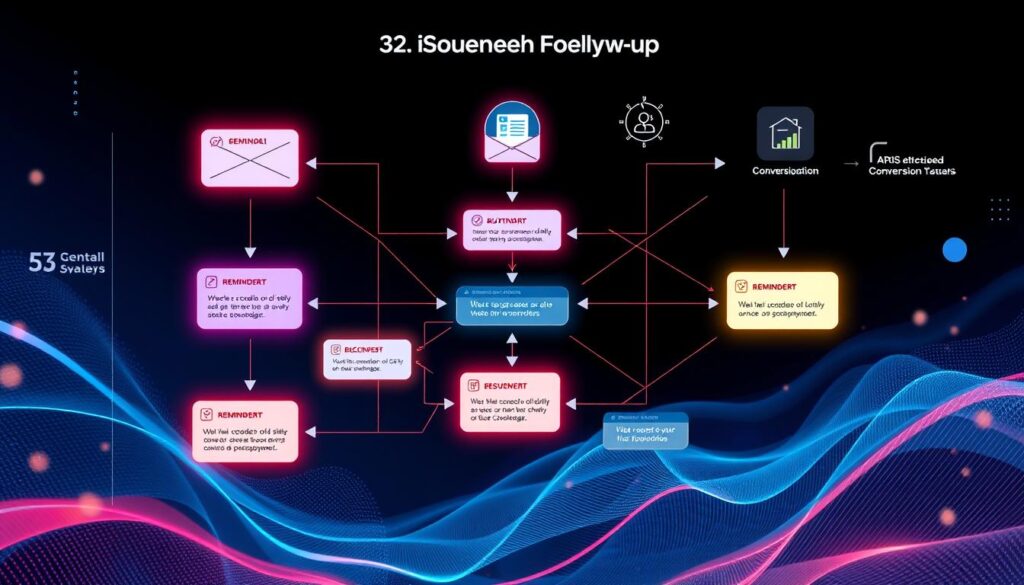In the competitive world of today, automated sales follow-ups are changing the game. They make engagement better and increase the conversion rate. Now, with AI tools, reaching more people with tailored messages is easier. Businesses are using CRM follow-up automation to talk to leads at the right time. This is crucial for turning prospects into customers.
AI is not just about automation. It creates personalized messages, like a sales rep would. This makes potential customers feel valued. Conversion rate enhancement is a huge benefit. With these systems, sales teams can focus on closing deals and building relationships.
Key Takeaways
- Adding automated sales follow-ups to your strategy can make lead management much better.
- Consistent, tailored talking to prospects boosts the conversion rate.
- AI in CRM follow-up automation offers a human touch to prospects, making it feel real and personal.
- Automated follow-ups let sales reps focus on more important tasks that need a personal touch.
- Automation helps improve the chances of success in finding prospects, as regular follow-ups are key to making sales.
- The way you customize and time your follow-ups can greatly increase your chances of making a sale.
What are Automated Sales Follow-ups?
In the fast world of sales, keeping ahead means using tools that make communication better. Automated sales follow-ups are one such tool. They use the latest tech to keep in touch with leads, making it more likely to close deals.
Definition and Importance
Automated sales follow-ups are systems that send messages automatically. They are a big part of marketing automation for sales. These systems help by making sure all leads get the attention they need without needing a human to do it. By using these tools, companies can send messages that fit each lead’s needs, helping build better relationships and increase sales.
How They Work
Automated lead nurturing uses smart algorithms to understand customer data. Tools work with CRM systems like HubSpot and Pipedrive, sending the right messages at the best times. New tools like LaGrowthMachine’s Magic Messages use AI to make messages even more appealing, making sure they hit the mark every time.
Key Benefits
Adding automated follow-up systems to your sales strategy has many perks. Here are the main ones:
- Enhanced Lead Engagement: Automated systems keep leads interested by offering them personalized information and solutions.
- Efficiency and Scalability: Automation lets one salesperson reach way more prospects than they could on their own.
- Increased Conversion Rates: With regular and personalized follow-ups, leads are more likely to become customers.
Stats say 80% of sales need at least five follow-ups. Automated systems make managing this much easier, making sales efforts more successful.
| Email Sequence Stat | Response Rate |
|---|---|
| First email | 18% |
| Sixth email | 27% |
The table shows how automated follow-ups can improve engagement. Each email increases the chance of a response, highlighting the importance of smart, ongoing communication for winning sales.
Why Your Business Needs Automated Follow-ups
In today’s digital world, businesses can’t ignore the power of automated follow-ups. These tools keep you connected with potential customers and make their experience better. After all, people are willing to pay 16% more for great service. With automation, your team can focus less on follow-up tasks and more on turning leads into sales.
Improving Lead Engagement
Automating your sales follow-ups is key to getting more leads interested. Responding quickly, like in just 5 minutes, can make you 100 times more likely to seal the deal than if you wait 30 minutes. Even though 82% of U.S. consumers want more personal touches in sales, automated follow-ups can still offer tailored, engaging content. This ensures every contact is valuable and on time.
Reducing Manual Effort
CRM follow-up automation majorly cuts down on manual work. Did you know sales teams only get to sell about 35% of the time? The rest is spent on tasks like scheduling follow-ups. Automation takes over these routine tasks. This lets sales reps focus on more important things, like forging relationships and closing deals, boosting both productivity and efficiency.

| Feature | Benefit | Impact |
|---|---|---|
| Auto-generated responses | Immediate engagement | 100x potential deal closure |
| Lead scoring automation | Efficient qualification of leads | Enhanced focus on promising leads |
| Personalized messaging | Better customer experiences | Higher willingness to pay up to 16% more |
Automated follow-ups are changing the game in our digital, customer-first world. By adopting these systems, companies not only work more efficiently but also build stronger relationships with potential buyers. This leads to more sales and growth for your business.
Elements of an Effective Automated Follow-up Strategy
Building an effective follow-up system takes careful planning. You need follow-up sequence software and lead segmentation to better communicate with prospects and customers. These tools can change how businesses reach out.
Personalization Techniques
Personalization makes automatic email campaigns effective. Adding the recipient’s name, actions, preferences, and relevant content can boost engagement. Personalized subjects can increase clicks by 22.2%. For further details, visit custom software solutions for business success.
Timing and Frequency
Finding the balance in email timing and frequency is key. Emails should be often enough to remember the brand but not so much that they annoy. This balance reduces the unsubscribe rate and spam markings.
Messaging Best Practices
Effective follow-up messages should be short and tailored to the recipient’s needs. Asking questions in your emails can up response rates by 50%. Adding polls or interactive elements makes responses more likely by 20-25%. This approach makes communication more personalized and interactive.
A good follow-up strategy meets various needs with automated email drip campaigns. It also sets a brand as a thought leader. Your content should offer value, build relationships, and uniquely position your offerings. This is crucial for long-term engagement and loyalty.
| Strategy Element | Description | Impact Percentage |
|---|---|---|
| Personalized Subject Lines | Uses recipient’s first name or relevant data | 22.2% Increase in CTR |
| Email Question Count | One to three questions per email | 50% higher response rate |
| Interactive Content | Integration of polls or surveys | 20-25% Improved responses |
| Email Timing | Maintaining optimal sending frequency | Reduces unsubscribe rates |
Tools for Implementing Automated Follow-ups
Businesses face tough competition today. They use advanced tools to keep up. These tools, like sales automation tools, CRM follow-up automation, and email automation software, help a lot. They make it easier to engage customers and improve sales.
CRM Solutions
CRM solutions are key to automating sales. They manage relationships and follow-up tasks. This lets sales teams focus on making sales. Tools like Salesforce Sales Cloud and HubSpot Sales Hub are great. They have features like lead scoring and work well with other software.
Email Automation Software
Email has gotten easier with Mailshake and Woodpecker. These help send the right emails at the right time. They react to what customers do and show detailed results. Email automation software keeps potential customers interested.
Chatbot Integration
Chatbots play a big role in sales. They start conversations and learn about leads. This helps when dealing with lots of questions. Chatbots answer simple questions right away. They send complicated ones to human agents.

| Tool | Starting Price (per month) | Special Features |
|---|---|---|
| Woodpecker | $20 | Automates follow-ups after 3, 7, and 10 days |
| Quickmail | $49 | Handles up to 30,000 emails with free trial |
| Smartlead | $39 | Customizable plans with a free trial |
| Mailshake | Custom | Time-triggered automated email follow-ups |
| Vocus | $5 | 30-day free trial to test features |
Using the right tools means success for businesses. CRM tools, automated emails, and chat services make a big difference. They use new technology and smart planning. These tools are a must for sales-focused companies. They help reach more customers and make more sales.
Measuring Success: Key Metrics to Track
For businesses using automated lead nurturing, understanding their impact is key. They can track and improve how they interact with potential leads by using detailed sales analytics.
Open Rates
Assessing the success of email campaigns starts with checking open rates in sales. This shows the share of people who opened an email. It tells you if your message is grabbing the attention of your target audience.
Response Rates
After open rates, look at how many people are engaging with your emails. Response rates show how well your content talks to your audience. It’s not just about opening an email but also about getting replies or clicks.
Conversion Tracking
At the heart of it, conversion tracking measures sales follow-up success. It shows how many leads turn into actual customers. This helps businesses fine-tune their nurturing strategies to improve sales.
By focusing on open rates, response rates, and conversion tracking, businesses can keep refining their methods. They gain insights to drive strategies that better engage customers and increase sales. A dynamic sales process that adapts to customer needs ensures better results.
Overcoming Challenges in Automated Sales Follow-ups
In the digital sales world, follow-up automation brings big benefits and challenges. Tackling these challenges well can greatly improve sales efforts in both speed and success.
Avoiding Spam Filters
One big challenge in follow-up automation is avoiding spam filters. To keep automated sales emails out of spam, they must be personalized and well-written. Using dynamic content tailored to lead details like demographics and actions can help. This makes emails more likely to reach inboxes and appeal to readers.
It’s also vital to update email content regularly. Following the latest guidelines from email providers is key to avoiding spam filters.
Maintaining a Human Touch
Even with automation, keeping a personal touch is crucial. Personalized messages that consider each recipient’s journey or past interactions can help. Training sales teams to use automated tools strategically allows for timely human intervention. This approach combines efficiency with the essential human touch, enhancing prospect relationships.
Using CRM tools that work well with email platforms helps too. This enables the automation of simple tasks without losing the personal element. Effective CRM use makes managing personalized experiences easier and more scalable.
Success in follow-up automation means finding a balance. It’s about using technology wisely while keeping interactions human and relatable.
Best Practices for Crafting Follow-up Messages
The secret to making follow-up messages that click with your audience is knowing two key things. First, how to create catchy subject lines. Second, how to write strong call-to-actions (CTAs). Doing these well can help turn interested people into real customers. It paves the way for them to trust you and keep coming back.
Crafting Compelling Subject Lines
Think of subject lines as the keepers of your email’s fate. Our study shows 33% of people decide to open an email based on its subject line. They must attract attention and promise something valuable. Use tools for testing different subject lines. Find out what your readers love. Your focus? Be clear, showcase the benefits, and keep true to your promises.
Keep these tips in mind for subject lines:
- Convey Urgency and Exclusivity: This pushes people to take quick action.
- Highlight Benefits Over Features: Show what’s in it for them, not just what you’re selling.
- Personalize: Using someone’s name or past interactions boosts your chance of getting noticed.
Writing Effective Call-to-Actions
The end game of follow-ups is to get a reaction. And that’s where a well-crafted CTA comes in. A great CTA is clear and tells the reader exactly what to do. Using ‘Register’, ‘Download’, or ‘Call today’ are good examples. With the right software, you can tailor these CTAs. This helps personalize your message based on each person’s history with you.
For CTAs that work, remember:
- Lever Clean Design: A standout button or font grabs attention.
- Create a Sense of Scarcity or Urgency: Saying ‘limited time offer’ can get more clicks.
- Keep It Simple: One clear request beats several.
Using smart subject lines and CTAs gets better with follow-up sequence software. This tech makes your messages personal and automated at the same time.
| Stage | Follow-up Action | Timing |
|---|---|---|
| Initial Contact | Send introduction email with personalized content. | Within 24 hours |
| Post First Follow-up | Send tailored content based on lead’s interaction. | 3-4 days later |
| Subsequent Follow-ups | Gradually introduce CTAs and value propositions. | Every 5-7 days |
Overall, using smart subject lines and powerful CTAs can make your follow-up messages more effective. It leads to more people engaging with what you offer. By using the latest follow-up sequence software, each message hits the right note. This tech adjusts to cater to different types of customers. And that leads to more sales and a successful business.
Real-world Success Stories of Automated Sales Follow-ups
Using automated sales follow-ups is more than just a theory. Many companies have seen real benefits. They’ve made more money and worked more efficiently thanks to this smart sales method. These true stories show just how much sales can change with the right technology.
Case Study: Monite and Autoklose
Monite started with just $15,000 and a team of 50. Now, they make $720,000 a year. Autoklose, on the other hand, earned $400,000 annually just four months after starting. Their annual earnings have since soared to $7.5 million with only 30 employees. This shows how automated follow-ups boost efficiency and revenue. These lead conversion case studies prove that with automation, you don’t need a huge team to grow your income significantly.
Case Study: SalesHandy and NetSpark IP & Telecom
SalesHandy’s team of 67 has reached an annual income of $1.5 million. This shows even large teams benefit from knowing how to use automation tools. NetSpark IP & Telecom improved how quickly they finish projects and how well they handle client relationships. They showed how automation could lead to happier customers and better business growth.
These stories are just a few examples of how automation has helped businesses. They show why it’s important to include automation in sales plans. The market for marketing automation might hit $13.71 billion by 2030. This growth is powered by the proven success of sales technology in boosting profits and changing how businesses work.
FAQ
What exactly are automated sales follow-ups?
Automated sales follow-ups are systems using AI to help businesses talk to potential clients regularly. They act like real conversations by sending the right messages at the best times. This approach makes lead nurturing through the sales funnel more effective.
Why are automated follow-ups critical to modern sales strategies?
In the fast world of sales today, automated follow-ups make sure every lead gets attention. They keep the conversation going, reply quickly, and tailor communications for each lead. This helps turn more leads into customers and boosts sales performance.
How can automated follow-ups reduce the manual effort in sales processes?
Automated follow-ups take over the job of sending out emails and reminders. Sales reps can then focus on high-value tasks like talking to promising leads and closing deals. They work with CRM systems to make managing leads and sales smoother.
What should be considered when crafting an automated follow-up strategy?
A good follow-up strategy needs personal messages based on what we know about each lead. It’s important to get the timing and frequency right to not bother prospects. The right software can customize messages for better engagement and more sales.
What tools can be used to implement automated follow-ups?
For automated follow-ups, businesses can use CRMs, email automation tools, and chatbots. The best tool depends on what the company wants to achieve with its customer interactions.
Which metrics should sales teams monitor to measure the success of automated follow-ups?
Teams should look at how many people open emails, reply, and finally buy something. These numbers help see how well follow-ups are working. They guide teams in making their messages better and selling more effectively.
How can businesses avoid having their automated follow-ups marked as spam?
To stay out of spam folders, messages must be well-written, relevant, and personalized. A human touch and careful sending frequency also help keep messages reaching their targets.
What are the best practices for writing effective automated follow-up messages?
Effective messages have eye-catching subject lines and are short and clear. They should offer something valuable and tell the reader what to do next. Automation software can personalize these messages at scale.
Are there real-world success stories that demonstrate the effectiveness of automated sales follow-ups?
Yes, many companies see better engagement and more sales with automated follow-ups. These success stories show how sales teams can work more efficiently and improve customer experiences. They offer great tips for businesses wanting to up their sales game.



